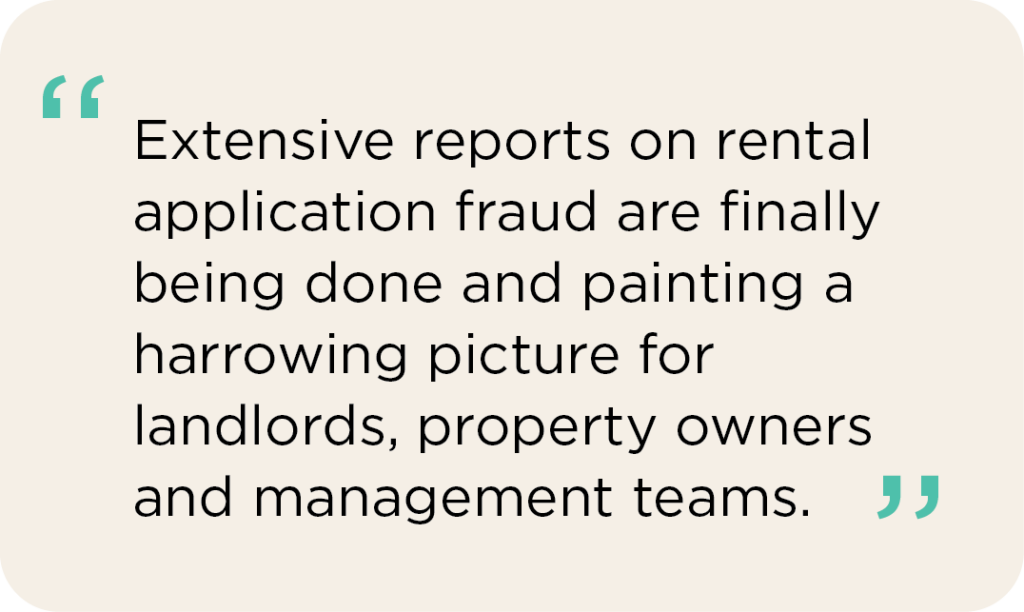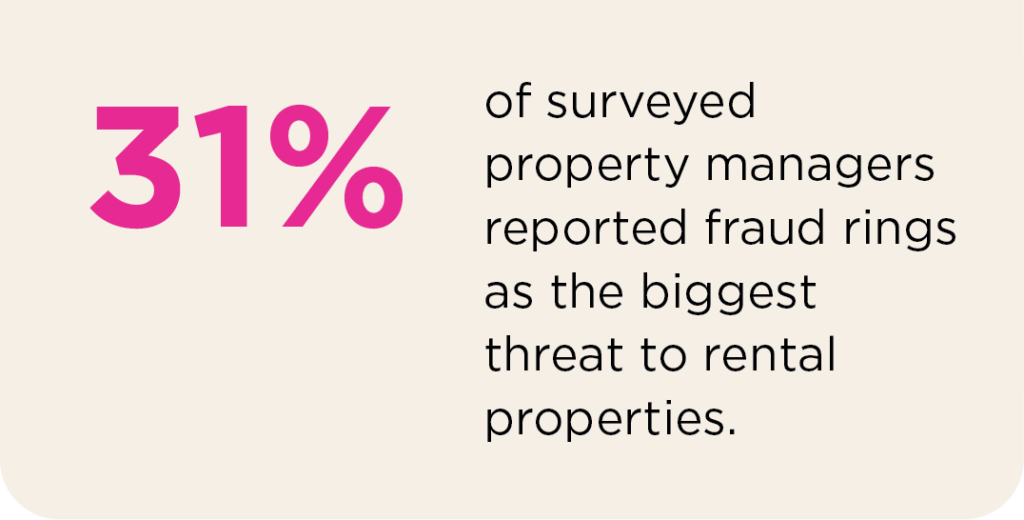Scams in the real estate industry are on a dangerous trajectory with year-over-year spikes in crimes involving seller impersonation schemes and identity theft. With profuse news coverage and government-issued warnings, extensive reports on rental application fraud are finally being done and painting a harrowing picture for landlords, property owners and management teams.
This article covers the logic behind the increasing regularity of these crimes, their multiple forms, and the consequential losses being suffered and afforded by property owners. Let’s begin with the multiple forms of identity theft being found in rental applications today. (73% of which is discovered after securing a lease resulting in expensive and lengthy eviction proceedings).
Beyond the scope of this article but at the forefront of the issue, recommended security protocols for rental property managers to mitigate fraud can be found here

Different forms of identity theft affecting rental property owners:
- Rental application fraud: The simple practice of lying on a rental application, whether it be providing false income or listing a friend as your previous “landlord”.
- Synthetic fraud: This is one of the fastest-growing types of fraud, an applicant creates a fake identity using both real and false information. For example, a falsely-constructed Social Security number paired with a real address to create a fake identity.
- First-party fraud: This type of fraud is performed by the individual, typically the tenant, where they provide fake or altered information, such as pay stubs and previous addresses, to qualify for a rental property.
- Third-party fraud: This is when an individual uses another person’s identity or information outright to qualify for a rental property, such as misrepresenting who they are with someone else’s Social Security number, name, and date of birth.
Probable causes of spiking fraud rates in rental applications:
- Ease of application: in 2018, a study commissioned by TransUnion sent up a flare regarding tenant application fraud. It also stated that 59% of rental applications were submitted online. In 2024, that number is now 92%, further reinforcing the relationship between online rental applications and soaring fraud rates.
- Ease of obtaining and creating fake documents: between photo-editing software, public records, and the rest of the internet, digital and physical documents have never been easier to come by and fabricate. They’re also easier to submit from behind the screens.
- Lack of consequences: only 3% of fraud cases are accepted in the courts, and 18% of stolen income recovered – and this mainly refers to seller impersonation fraud. Scams regarding rental properties are far under the radar in comparison, giving criminals a go-ahead to target multi-family housing.
- Lack of housing supply: desperate people do desperate things. Pushed far enough, the desperate become dangerous. Among the fraud rings and criminals, average folks are turning to rental application fraud in droves as a result of the housing shortage, high mortgage rates, and heightened cost of living. Shelter is a basic need, and worth the risk of faking a pay stub for many.
- For free shelter: squatting has likely been an issue since we lived in caves, but it’s more expensive these days. There’s always a system for working the system, and tech-savvy squatters can delay eviction proceedings for years without handing over a dime. Working this particular system used to take years of experience and grit, but can now be quickly mastered with nothing but wifi and literacy. While they squat in one rental, they have ample time to plan their next escape to the next.
- For profit through illegal means: 31% of surveyed property managers in a recent comprehensive study from RealPage reported fraud rings as the biggest threat to rental properties. This refers to criminals using rental units as a home base for drug and/or sex trafficking, as well as renter impersonation schemes. For these schemes, the fraudster poses as the property manager and swindles potential tenants out of fake rental application fees, security deposits, and traditional first and last months’ rent.

What’s at stake for rental property managers:
Crime rates are expected to continue rising for the foreseeable future. Meeting strangers inside private residences literally opens the door to risk, as does signing their lease. To combat tech-savvy scam artists and desperate rental applicants that beat average tenant screenings, leverage standard Self-Tour technology with biometric identity verification, verifiable access records, and tie-in surveillance devices to guard your doors in real time and in court. For more information on how these scam and fraud prevention, there’s more information here
Citations
National Multifamily Housing Council. Quick facts: Resident demographics. (n.d.). https://www.nmhc.org/research-insight/quick-facts-figures/quick-facts-resident-demographics/
RealPage. National Multifamily Fraud Research Study. (2024, March 26). RealPage. https://www.realpage.com/ebooks/uncovering-impact-of-rental-application-fraud/58aabc2a-eba3-11ee-b189-005056ae66af/
TransUnion. (2018, September 5; updated May 2023). Fraud: the new operational headache in property management. https://newsroom.transunion.com/fraud-the-new-operational-headache-in-property-management/
United States Secret Service Cybercrime Investigations. (2023). Real estate scams. https://www.alta.org/file?name=Seller-Impersonation-Fraud
Conclusion.
Combating real estate scams demands a proactive approach centered on robust security measures and preventative strategies. Implementing biometric identity verification enhances protection against fraudsters, safeguarding assets and preventing financial ruin. By prioritizing these steps now and monitoring listings, property owners can significantly reduce the risk of falling victim to fraudulent activities.





